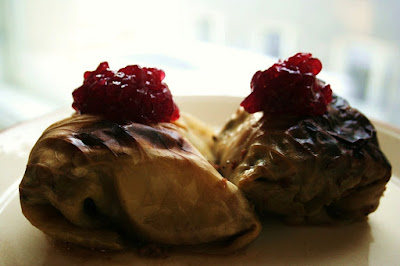
Since I decided to
make more of my own breads, the next logical step was to start my own sourdough. After all, 50 g piece of baker's yeast costs as much as 20 cents. Many people also find levain bread friendlier to their stomachs than more aggressive commercial yeast.
There's a strong consensus saying nothing's more Finnish than rye bread. However, it didn't become widespread before the middle ages, when Finns learned the leavening from Germans. Rye bread of today is always sour, since it doesn't digest all too well without the process. Also, it wasn't until the 18th or 19th century before rye gained barley in the popularity contest.
Actually I find it odd that rye bread is basically only known in Scandinavia, Russia and Baltia, even in our global era when new healthy groceries are ceaselessly seeked for. Every time I make a visit elsewhere in Europe and have to eat those white buns they call bread, I start to feel ill. I mean it's OK to enjoy one occasionally with a nice cup of coffee but how can anyone live with something that has no nutrients or fiber?
Today the levains are kept as family or bakery jewels from generation to generation and each of them make bread of a distinct taste. I have no idea what constitutes the best possible levain if you start it out fresh, so I just relied on a recipe from
my favourite cook book, but replaced the cow milk. I wasn't sure if that was going to work, since the idea is to grow both lactobacilli and wild yeasts, but it did start to bubble in couple of days. Then I read more about the organisms for example from
here and
here and added a couple of more ingredients in the hope they would also produce some interesting life forms. I'll document here how I made it, but I recommend you to read about the process yourself, compare different recipes and try forming one out yourself.
- 1 l rye flour
- 1/2 l water
- 2 tbsp probiotic oat or soy yogurt
- piece of your favourite organic yeastless rye bread
(Only the first two are truly essential.)
Boil the water for about ten minutes. Let it cool down to lukewarm. Tear the bread in pieces and dissolve them in the water. Mix in the yogurt and finally the flours. Cover with a towel and leave it in a warm room. (Wonder how Englishmen do this part?) Feed the levain with 1 dl flour a day for about a week. In this time it should start to develop air and smell sour. Freeze the parts you won't need immediately or keep feeding it. In the future, every time you make a dough, put a fist sized piece aside. Apparently the taste of the bread you leaven with this is just plain sour at first, but it should get more distinctive the more you use it.
I'll be reporting more about how I succeeded with this. If I'm happy with it I may really get really carried away and start experimenting with other kitchen pets as well.
 Kalja or kotikalja or vaarinkalja is a typical Finnish table beer you see in any canteen or formal feast. It's dark and often sweet but low in alcohol which is why the bizarre Finnish alcohol laws or strict attitude towards alcohol drinks don't apply to it. (I often hear people say we've got a liberal attitude towards alcohol. That's simply not true. Even a glass of wine is generally considered as getting pissed.) My mum always has some in the fridge. As a kid I used to drop sugar cubes in my glass just to see kalja foam.
Kalja or kotikalja or vaarinkalja is a typical Finnish table beer you see in any canteen or formal feast. It's dark and often sweet but low in alcohol which is why the bizarre Finnish alcohol laws or strict attitude towards alcohol drinks don't apply to it. (I often hear people say we've got a liberal attitude towards alcohol. That's simply not true. Even a glass of wine is generally considered as getting pissed.) My mum always has some in the fridge. As a kid I used to drop sugar cubes in my glass just to see kalja foam.















